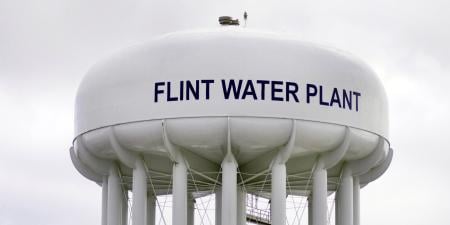Abstract
This article reviews the regulation of lead in drinking water, highlighting its epidemiological, engineering, and ethical aspects with a focus on the Flint water crisis. We first discuss water quality policy and its implementation with a focus on lead contamination of water, primarily from pipe systems between a water treatment facility and a tap. We then discuss physicians’ roles and ethical responsibilities regarding safe drinking water using a human rights framework. We argue that physicians can play an important role in safeguarding drinking water in their communities by being vigilant, honoring the community’s trust in them, and warning, educating, and empowering patients and broader communities so as to protect tap water safety and public health.
Introduction
Safe drinking water is a key factor in health and well-being. Children are particularly vulnerable to the health effects of unsafe drinking water, which include not only diarrheal disease but also diseases linked to inorganic pollutants such as arsenic, copper, fluoride, lead, and nitrate [1]. Fetal and early childhood exposure to such contaminants can cause neurological damage and developmental impairments with lifelong consequences [2, 3]. Recent cases involving lead contamination in municipal water systems, such as occurred in Washington, DC, in 2003-2004 [4] and in Flint, Michigan, in 2014 [5] illuminate significant health risks and failures of existing public health and governmental systems to respond robustly to contamination risks. This article reviews the regulation of lead in drinking water, highlighting its epidemiological, engineering, and ethical aspects with a focus on the Flint water crisis.
Regulation of Lead Levels in Water, but Not Blood
It was not until the Clean Water Act of 1972 [6] and the Safe Drinking Water Act (SDWA) of 1974 [7] that systematic water safety regulation began in the US. The SDWA was significantly strengthened and expanded in 1986, when the Environmental Protection Agency (EPA) was authorized to set regulatory standards, one of which was the Lead and Copper Rule (LCR) issued in 1991 [8]. The LCR sets an “action level” for lead—a point at which regulators must take steps to reduce risk—of 15 parts per billion (ppb) in 1 liter of tap water standing in pipes for at least 6 hours [9]. Lead, the toxicity of which has been known since ancient times, is a particular concern in environmental health today. Beginning in the early 1970s, the EPA gradually reduced the amount of tetraethyl lead permitted for use in on-road vehicles, which culminated in a complete ban in 1996 [10]. Since then, the legislative and regulatory focus on environmental lead exposures has been on physical particulates, such as house paint containing lead, and lead contamination of drinking water. In 1991, the EPA estimated that between 14 and 20 percent of total lead exposure was from drinking water [11]. Further changes to the SDWA in 1992 and 1996 strengthened protections of drinking water, but the LCR action level has remained unchanged [12].
While the LCR addresses lead concentration in tap water, no toxic threshold has been identified in human blood levels of lead (BLLs) because research suggests that no blood lead level is a “safe” level, for either adults or children [3, 13-15]. Young children, infants, and developing fetuses have been the most susceptible to lead exposures [16, 17]. In children, BLLs as low as 10 μg/dL (100 ppb) or even 5 μg/dL (50 ppb) are a causal risk factor for developmental impairments and neurobehavioral disorders such as hyperactivity and attention deficit disorder [2, 3]. From 2007 to 2010, approximately 535,000 US children aged 1-5 years had BLLs of at least 50 ppb [2]. To the extent practically feasible, the various sources of lead exposure, including but not limited to tap water, should be identified and mitigated. The situation of “practical feasibility” is complex and includes technological possibility, cost effectiveness, and value priorities set by political forces and the influence of past regulatory objectives. As Brown and Margolis point out, “Current water sampling protocols were designed to assess the adequacy of water treatment, not the level of human exposure to lead. Important fluctuations in water lead levels might be missed because of limitations inherent in sampling protocols developed for regulatory purposes” [18].
Water Regulation, Monitoring, and Management
Water withdrawn directly from rivers, lakes, reservoirs, and underground aquifers is rarely safe enough for human consumption if not subjected to some degree of treatment. In the case of lead, the contamination usually comes from the distribution system rather than the treated source. Older homes were often built with lead plumbing and fixtures, and those built more recently might contain lead solder [19]. Drinking fountains in schools have lead in their storage tanks [19]. Millions of American homes and buildings receive water from service lines that are at least partially lead [20, 21].
The goals of the SDWA and the LCR are difficult to meet for several reasons. One is the diffuse nature of the water management system in the US. As public health historian David Rosner observes, “In the United States there are 155,000 separate water systems serving communities and institutions, which leads to a haphazard system of enforcement” [22]. These systems may be publicly or privately owned. Many households are not subject to regulation because they draw untreated water from private wells that are not regulated by the EPA. The responsibility for ensuring that public drinking water systems actually meet the SDWA standards is divided among the EPA, state governments, tribal governments, and private water systems acting as public utilities [12, 22].
This regulatory system is based upon regular monitoring and reporting by local officials. In 1986, amendments to the SWDA required that new or revised drinking water standards be developed for 83 specific contaminants and called for the addition of contaminant standards thereafter [12]. Water sampling frequency requirements vary for each contaminant group. The primary contaminant group that contains lead is inorganic chemicals. Other contaminants within this group are arsenic, asbestos, chromium, copper, fluoride, mercury, and nitrate [23]. Radionuclides comprise a separate contaminant group, as do organic chemicals, microorganisms, and turbidity [23]. Water sampling requirements also vary with the size of the water distribution system. Some small systems collect as few as five samples per year, and some large systems only collect 50 to 100 [24]. Detection of a contaminant above a certain level sometimes triggers increased sampling requirements. The EPA and the states primarily monitor public water system compliance with the SDWA and the LCR standards through review and evaluation of water quality test results and reports, usually done by certified laboratories [25]. Under the LCR, water systems serving more than 50,000 residents must have “optimal corrosion control treatment” regardless of the tested lead level [26]. In water systems serving fewer than 50,000 residents, when results indicate that more than 10 percent of sampled homes have a lead level that exceeds the action level, “the utility must identify and install optimal corrosion control treatment” [26]. The EPA requires, by law, that water systems control the corrosivity of their water so that lead in the pipes does not enter the water as it passes through [8]. The current lead action level of the LCR, developed in 1991, was based on the feasibility of reducing lead with the corrosion control technologies available at that time. Ideally, as remediation technologies improve, regulation will adjust as well by incorporating the most effective control methods. Timely public notification is required to advise consumers of potential health hazards and to identify steps people should take to protect their health regardless of the size of the water system’s population [9].
This regulatory system, however, is imperfect. The LCR permits up to 10 percent of homes to exceed the action level of 15 ppb. Moreover, the LCR requires public water systems to test tap water in a comparatively small number of homes with lead pipes—50 to 100 homes for large systems—and intervals between testing can extend from six months to three years, depending on the levels of lead [24]. Although water systems use various procedures for tap water tests that specify how long tap water must be run before a test sample is drawn and other protocols that lead to accurate test results, they can easily be compromised by inattention or lack of proper training. Nevertheless, regulations allow homeowners to conduct these tests unsupervised, and hence the data reported might not always be reliable [19, 20, 27].
Complex Regulatory and Value Choices
No matter how sophisticated the quality control and monitoring methods, health and safety will not be well served if prevailing financial and ideological considerations compromise their use, if regulations are interpreted in an overly permissive way, or if regulations are flouted by officials. It has become clear that this happened in Flint, where a new water supply system (the Flint River) was adopted to save money in the fiscally stressed city in 2014. Chemicals required to treat the Flint River water were known to have corrosive properties that released lead inside the pipes of the city’s water system and contaminated drinking water [28]. Yet other corrosion-inhibiting chemicals that would have formed a protective layer on interior pipe surfaces, reducing dissolution of lead into water, were not also used [28, 29]. The irony of Flint was that the city and state could have treated the water with these anticorrosive chemicals for a cost of about $100 per day. Now it faces the cost of repairing the entire system for $1.5 billion [29]. The cost of lead remediation for the entire country is estimated at $1.3 trillion [29]. These are the costs of fixing pipes; the cost of providing medical care for those who have already been—or will be—affected by lead exposure if better protective measures are not taken has yet to be calculated [1, 2, 12].
Even when large water systems are managed or replaced to deliver noncontaminated drinking water, lead contamination can still occur as water travels through or sits for long periods in internal plumbing of commercial or residential buildings. If interior plumbing presents a risk, one effective way to reduce metal concentrations in household drinking water is to flush the plumbing system by running water for up to two minutes before drinking the water [30]. At the community and personal level, physicians can play a particularly important role in public health outreach to and education of residents of high-risk sites.
Physicians and Communities Working Together
In Flint, after the concerns and complaints of residents and parents were dismissed and ignored by local and state officials for many months, the voices of Marc Edwards, an engineer whose team members documented water lead levels, and Mona Hanna-Attisha, a pediatrician whose team documented blood lead levels, were essential in getting government officials to publicly acknowledge that lead in the water was causing lead poisoning in children [22]. Yet documenting objective risk and harm is only one of several activities that help enable access to safe, uncontaminated drinking water, which physicians should consider to be within the purview of their professional ethical responsibilities.
The foundation for this set of responsibilities pertains to physicians as professionals and as ethical persons; it is that equitable access to safe drinking water is a human right [31]. This right is recognized in virtue of the essential biological role that fresh water plays in human life. As a principle of justice and a human right, access to this necessary substance cannot be limited in arbitrary or discriminatory ways; and in fulfilling this right, societies are obligated to make resources available and to prohibit conduct that violates this right, even if lower priority must be given to other social interests and preferences. In turn, the specific ethical responsibilities incumbent on physicians qua physicians stem from at least three factors:
- Physicians’ scientific training and knowledge. This should include health risks associated with water contaminants, such as lead. Arguably, physicians, such as pediatricians, who serve some of communities’ most vulnerable patients, should be prepared to identify those community members’ risks from such contaminants.
- Physicians’ social authority and community trust. Physicians are obligated to fulfill public trust by drawing upon their knowledge and credibility regarding environmental health and safety. Many health and environmental regulations, such as the LCR, call for standards and conditions that are “optimal,” which is a complex notion that is subject to dispute when it is operationalized by particular engineering requirements. For example, from an engineering standpoint, drinking water systems ought to take into consideration cost, feasibility, potential for scaling, ease of handling chemicals, and potential to increase other undesirable water quality characteristics such as turbidity, the acidity of the water, and the like. From a medical and health perspective, however, “optimal”—at least when it comes to BLLs and the multiple pathological effects of lead—is a value-laden notion. It does not entirely embrace the calculus of costs and benefits calibrated in monetary terms, and it suggests a preventative and precautionary priority. Physicians are well positioned to keep a community’s focus on what is morally right and obligatory.
- Physicians’ strategic position as brokers and mediators between public officials and corporate leaders, on the one hand, and community members, on the other. In virtually every community there are some who are socially and economically disadvantaged and vulnerable to environmental health injustices and risks associated with poorly managed drinking water systems. These persons need physicians to exercise the duty to warn of the risks and to advocate for the health interests of those who cannot protect themselves. Government, corporate, and civic leaders, who themselves have a duty and a public trust, also need physicians to remind them about the importance of safe drinking water to public health.
Physicians should carefully monitor and recognize not only blood levels but also developmental and behavioral signs of toxic exposure. They can also learn about concerns from their patients’ reports of changes in the quality of water they use. Physicians’ insights into possible health effects of poor water quality can also come from their broader engagement in civic affairs, such as attending community meetings, being in touch with local college and university faculty, and being active in local health professional societies and service organizations. Required water testing, as has been noted, is episodic and does not always result in symptom identification or early warning of contamination problems. Communication between physicians and patients is a supplemental facet of public health surveillance that can be vital for protecting patients from exposure or further exposure to lead-contaminated water.
Physician communication with patients and community members can help inform and warn. Physicians can educate their patients and families about precautionary measures and about the availability of testing and remediation support for older plumbing and fixtures, just as they have been attentive in the past to the hazards of peeling lead-based paint and leaded gasoline [13].
Finally, lead contamination is not a problem that can be solved within clinical encounters, so physicians are obliged as citizens and professionals to play more active civic roles as advocates. Physicians’ reliance on their medical expertise and their reputation for general respect and trustworthiness can have significant impact on local affairs in several ways. Physicians can serve on local government panels. They can become active in local not-for-profit environmental and health organizations. They can work with professionals from other disciplines, such as environmental engineers and chemists, while serving as pro bono advisors to neighborhood and civic groups.
When it comes to safe drinking water, the voice of physicians can be a voice for the ethical values of equity and social justice, a voice for the futures of children, and a voice for transparency and accountability. Physician leadership can make a difference to water policy and regulation, and it is sorely needed [28].
References
-
Hunter PR, MacDonald AM, Carter RC. Water supply and health. PLoS Med. 2010;7(11):e1000361. http://journals.plos.org/plosmedicine/article?id=10.1371/journal.pmed.1000361. Accessed July 11, 2017.
-
Council on Environmental Health. Prevention of childhood lead toxicity. Pediatrics. 2016;138(1):e20161493. http://pediatrics.aappublications.org/content/138/1/e20161493.long.Accessed July 11, 2017.
- Canfield RL, Henderson CR Jr, Cory-Slechta DA, Cox C, Jusko TA, Lanphear BP. Intellectual impairment in children with blood lead concentrations below 10 μg per deciliter. N Engl J Med. 2003;348(16):1517-1526.
- Guidotti TL, Calhoun T, Davies-Cole JO, et al. Elevated lead in drinking water in Washington, DC, 2003-2004: the public health response. Environ Health Perspect. 2007;115(5):695-701.
- Hanna-Attisha M, LaChance J, Sadler RC, Champney Schnepp A. Elevated blood lead levels in children associated with the Flint drinking water crisis: a spatial analysis of risk and public health response. Am J Public Health. 2016;106(2):283-290.
-
Clean Water Act, 33 USC sec 1251-1387 (1972).
-
Safe Drinking Water Act of 1974, Pub L No. 93-522, 88 Stat 1660. https://www.gpo.gov/fdsys/pkg/STATUTE-88/pdf/STATUTE-88-Pg1660-2.pdf. Accessed August 14, 2017.
-
Maximum contaminant level goals and national primary drinking water regulations for lead and copper; final rule. Fed Regist. 1991;56(110):26460-26564.
- Brown MJ, Margolis S. Lead in drinking water and human blood lead levels in the United States. MMWR Suppl. 2012;61(4):1-9.
-
EPA takes final step in phaseout of leaded gasoline [news release]. Washington, DC: Environmental Protection Agency; January 29, 1996. https://archive.epa.gov/epa/aboutepa/epa-takes-final-step-phaseout-leaded-gasoline.html. Accessed August 14, 2017.
- Maas RP, Patch SC, Morgan DM, Pandolfo TJ. Reducing lead exposure from drinking water: recent history and current status. Public Health Rep. 2005;120(3):316-321.
- Levin RB, Epstein PR, Ford TE, Harrington W, Olsen E, Reichard EG. US drinking water challenges in the twenty-first century. Environ Health Perspect. 2002;110(suppl 1):43-52.
- Sanborn MD, Abelsohn A, Campbell M, Weir E. Identifying and managing adverse environmental health effects: 3. Lead exposure. CMAJ. 2002;166(10):1287-1292.
-
Wilson R, Healey N, Damman H, Richardson M. Lead (Pb) risk assessment in Canada. Part I: critical review of toxicity reference values. Ottawa, ON, Canada: Health Canada; 2005.
- Brodkin E, Copes R, Mattman A, Kennedy J, Kling R, Yassi A. Lead and mercury exposures: interpretation and action. CMAJ. 2007;176(1):59-63.
- Calderon RL. The epidemiology of chemical contaminants of drinking water. Food Chem Toxicol. 2000;38(suppl 1):S13-S20.
- DeWitt RD. Pediatric lead exposure and the water crisis in Flint, Michigan. JAAPA. 2017;30(2):43-46.
-
Brown, Margolis, 7.
-
Environmental Protection Agency. Protect your family from exposures to lead. https://www.epa.gov/lead/protect-your-family-exposures-lead.Updated May 23, 2017. Accessed August 18, 2017.
-
Environmental Protection Agency. Basic information about lead in drinking water. https://www.epa.gov/ground-water-and-drinking-water/basic-information-about-lead-drinking-water. Updated July 12, 2017. Accessed August 6, 2017.
-
American Water Works Association. Buried no longer: confronting America’s water infrastructure problem. https://www.awwa.org/Portals/0/files/legreg/documents/BuriedNoLonger.pdf.Accessed August 18, 2017.
-
Rosner D. Lead poisoning crisis enters its second century. Health Aff (Millwood). 2016;35(5):758.
-
Environmental Protection Agency. National primary drinking water regulations. https://nepis.epa.gov/Exe/ZyNET.exe/P1005EJT.TXT?ZyAction D=ZyDocument&Client=EPA&Index=2006+Thru+2010&Docs=&Query=&Time=&EndTime=&SearchMethod=1&TocRestrict=n&Toc=& TocEntry=&QField=&QFieldYear=&QFieldMonth=&QFieldDay=&IntQFieldOp=0&ExtQFieldOp=0&XmlQuery=&File=D%3A%5Czyfiles%5CIndex%20Data%5C06thru10%5CTxt%5C00000011%=5CP1005EJT.txt&User=ANONYMOUS&Password=anonymous&SortMethod=h%7C-&MaximumDocuments=1&FuzzyDegree=0&ImageQuality=r75g8/r75g8/x150y150g16/i425&Display=hpfr&DefSeekPage=x&SearchBack=ZyActionL&Back=ZyActionS&BackDesc=Results%20page&MaximumPages=1&ZyEntry=1&SeekPage=x&ZyPURL.Published 2009. Accessed August 14, 2017.
-
Control of lead and copper, 40 CFR sec 141.80-141.91 (2017).
-
Tiemann M. Safe Drinking Water Act (SDWA): a summary of the act and its major requirements. Congressional Research Service; March 1, 2017. https://fas.org/sgp/crs/misc/RL31243.pdf. Accessed June 19, 2017.
-
Brown, Margolis, 5.
- Sobsey MD. Drinking water and health research: a look to the future in the United States and globally. J Water Health. 2006;4(suppl 1):17-21.
- Bellinger DC. Lead contamination in Flint—an abject failure to protect public health. N Engl J Med. 2016;374(12):1101-1103.
- Gostin LO. Politics and public health: the Flint drinking water crisis. Hastings Cent Rep. 2016;46(4):5-6.
-
Environmental Protection Agency. Lead in your drinking water; actions you can take to reduce lead in drinking water. https://nepis.epa.gov/Exe/ZyNET.exe/20001R4V.TXT?ZyActionD=ZyDocument&Client=EPA&Index=1991+Thru+1994&Docs=&Query=&Time=&EndTime=&SearchMethod=1&TocRestrict=n&Toc=&TocEntry=&QField=&QFieldYear=&QFieldMonth=&QFieldDay=&IntQFieldOp=0&ExtQFieldOp=0&XmlQuery=&File=D%3A%5Czyfiles%5CIndex%20Data%5C91thru94%5CTxt%5C00000007%5C20001R4V.txt&User=ANONYMOUS&Password=anonymous&SortMethod=h%7C-&MaximumDocuments=1&FuzzyDegree=0&ImageQuality=r75g8/r75g8/x150y150g16/i425&Display=hpfr&DefSeekPage=x&SearchBack=ZyActionL&Back=ZyActionS&BackDesc=Results%20page&MaximumPages=1&ZyEntry=1&SeekPage=x&ZyPURL.Published 1993. Accessed August 14, 2017.
- Gleick PH. The human right to water. Water Policy. 1998;1(5):487-503.



